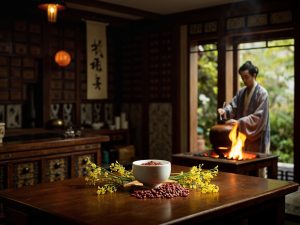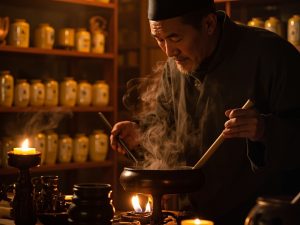Table of Contents
ToggleZhen Wu Tang – Nan Kaiyang
Author: Nan Kaiyang Editor: Gu Yuxi Translator: Gu Yuxi
Article:
Differentiation and Treatment of Taiyang Disease, Chapter Six (Middle)
82. For Taiyang disease where sweating has been induced, but the fever persists despite sweating, and the patient experiences palpitations below the heart, dizziness, twitching of the body, and a trembling sensation as if about to fall or collapse ; Zhen Wu Tang is indicated.
Differentiation and Treatment of Shaoyin Disease, Chapter Eleven
316. For Shaoyin disease that has not resolved for two or three days, extending to four or five days, with abdominal pain, difficulty with urination, heavy and painful limbs, and spontaneous diarrhea; this indicates the presence of water qi . The patient may also experience coughing, or improved urination, or diarrhea, or vomiting; Zhen Wu Tang is indicated.
Application
Zhen Wu Tang is suitable for individuals with Shaoyin Yang deficiency accompanied by water qi. The pathogenesis involves two aspects: Yang deficiency and internal retention of water-dampness. Among these, Yang deficiency refers to Kidney Yang deficiency, a more severe condition where both the Heart and Kidneys are weak. Symptoms may include a desire to sleep, a faint and thready pulse, and spontaneous diarrhea with thirst (the diarrhea here is not hot dysentery, but rather a loss of body fluids). The original text mentions a series of symptoms appearing after inducing sweating in Taiyang disease, which can be explained as damage to Yang by excessive sweating. Clinically, it is commonly seen in patients with prolonged illness, the elderly and frail, or those with chronic diseases who have both Heart and Kidney deficiency and internal retention of water-dampness. If the symptoms match those indicating Zhen Wu Tang, the effect is remarkably good.
Key Application Points for Internal Retention of Water-Dampness
1.Clinically, patients with internal retention of water qi often do not experience thirst. If a patient with internal water-dampness does experience thirst, it should be considered Shaoyin Yang deficiency thirst, meaning “thirst pertains to Shaoyin.”
2.“Body twitching and moving” refers to water qi entering the collaterals. Yang deficiency prevents proper nourishment of the channels and collaterals, leading to body twitching. The more one exerts force, the more severe the twitching. It is often accompanied by slight skin twitching, differing from convulsive spasms. A typical example is when a certain muscle in the limbs twitches for no apparent reason, commonly observed when lying down.
3.The Shaoyin pulse is often deep. This syndrome belongs to the Three Yin patterns, characterized by weak Yang Qi or Yang deficiency combined with damp evil. Regardless of the severity or urgency, Zhen Wu Tang can be the main formula. It is suitable for patients on long-term hormone therapy or chemotherapy. As long as the differentiation is accurate, its effectiveness is like “hitting a drum with a drumstick” , meaning immediate and significant.
Clinical Applications (For Reference Only)
For Lung problems using Zhen Wu Tang:
For lung infection, lung qi stagnation, congestive enlargement, and severe edema, indicating lung qi obstruction and inability to diffuse and descend, Zhen Wu Tang should be the primary formula. It can be combined with Ma Xing Shi Gan Tang, Yue Bi Tang, and supplemented with herbs like Houttuynia cordata, Scutellaria baicalensis, Peucedanum praeruptorum, Citrus reticulata peel, and Pinellia ternata. If there is severe edema with pleural effusion or ascites, Zhen Wu Tang can be combined with Wu Ling San, adding Plantago asiatica seed, Stephania tetrandra, etc. If the patient presents with symptoms of internal blood stasis, combine with Xue Fu Zhu Yu Tang, Ge Xia Zhu Yu Tang, etc. If there is Yin deficiency of the Heart and Lungs leading to shortness of breath, dry cough, vexation with palpitations, and a red tongue with scanty fluid, combine with Yin-nourishing herbs like Yi Guan Jian, Sheng Mai San, etc.
For Kidney disease, Diabetes:
Fu Ling (Poria), Gan Cao (Licorice), Bai Shao (White Peony Root), Dan Shen (Salvia Miltiorrhiza), Shu Fu Zi (Prepared Aconite Root), Sheng Jiang (Fresh Ginger), Bai Zhu (White Atractylodes Rhizome), Gui Zhi (Cinnamon Twig), 9g each. Modifications: For concomitant heat toxin, add Lian Qiao (Forsythia Fruit) 10g, Huang Lian (Coptis Rhizome) 6g, Huang Qin (Scutellaria Root) 9g. For Qi stagnation with fullness, add Chai Hu (Bupleurum Root) 9g, Hou Po (Magnolia Bark), Zhi Ke (Bitter Orange) 10g. For Qi deficiency, add Huang Qi (Astragalus Root), Dang Shen (Codonopsis Root) 15g. For blood stasis, add E Zhu (Curcuma Zedoaria), Hong Hua (Safflower), San Leng (Sparganium Rhizome) 9g.
Idiopathic Edema:
Fu Pian (Prepared Aconite Root) 10-20g, Bai Shao (White Peony Root) 15g, Fu Ling (Poria) 20g, Bai Zhu (White Atractylodes Rhizome), Sheng Jiang (Fresh Ginger), Ze Xie (Alisma Rhizome), Xian Ling Pi (Epimedium) 10g, Rou Gui (Cinnamon Bark) 6g, Che Qian Cao (Plantago Herb) 12g. For lower back and knee soreness and aversion to cold limbs, add Du Zhong (Eucommia Bark), Tu Si Zi (Cuscuta Seed). For poor appetite, add Da Fu Pi (Areca Peel), Chen Pi (Tangerine Peel), Qing Pi (Green Tangerine Peel), Chao Mai Ya Gu (Stir-fried Barley Malt). One course of treatment is seven days.
Meniere’s Syndrome:
Medicinal herbs: Dan Fu Pian (Prepared Aconite Root), Pao Jiang (Prepared Ginger) 6-15g each, Bai Zhu (White Atractylodes Rhizome), Gou Teng (Uncaria Hook), Fu Ling (Poria), Bai Shao (White Peony Root), Ju Hua (Chrysanthemum Flower) 10-15g each, Dang Shen (Codonopsis Root) 5-30g, Zhen Zhu Mu (Mother-of-Pearl), Dai Zhe Shi (Hematite) 30g each, Yuan Zhi (Polygala Root) 6g. If the tongue coating is thick, remove Dang Shen and add Ban Xia (Pinellia Tuber), Chen Pi (Tangerine Peel). For severe vomiting, add Jiang Zhu Ru (Bamboo Shavings with Ginger Juice). Generally, 5-7 doses are sufficient.
Benign Prostatic Hyperplasia (BPH):
Pao Fu Zi (Prepared Aconite Root), Huang Qi (Astragalus Root), Dan Shen (Salvia Miltiorrhiza), Hua Shi (Talc), Bai Shao (White Peony Root) 15g, Bai Zhu (White Atractylodes Rhizome), Che Qian Zi (Plantago Seed), Sheng Jiang (Fresh Ginger), Yin Yang Huo (Epimedium) 12g, Ju He (Orange Seed), Sheng Ma (Cimicifuga Rhizome) 10g, Hu Po (Amber) (dissolved in liquid) 3g. One course of treatment is ten days. The effectiveness rate is 90%.
Disclaimer:
The experiences and insights shared above represent the author’s personal usage and understanding, and are provided for reference only as part of academic exchange. Please do not blindly replicate or apply them; any consequences arising from such actions are solely your responsibility. As individual constitutions vary, medication should be tailored accordingly. It is advisable to use such treatments under the guidance of a qualified physician. If you have additional experiences to share, comments and submissions are welcome.
If you appreciate my article, please give it a like.
If you are a generous and affluent individual, please consider making a donation!
Your recognition is my greatest motivation to continue writing—thank you very much!
USD Donation Button —
A RMB donation button is available below.
 微信赞赏
微信赞赏 支付宝赞赏
支付宝赞赏




